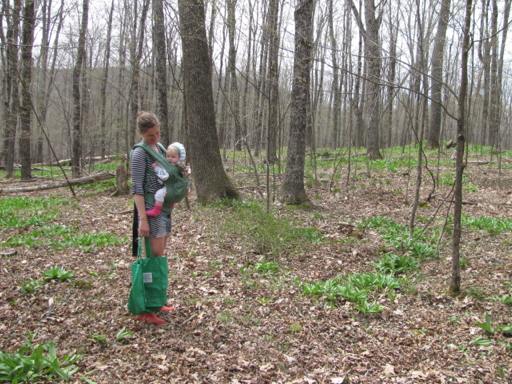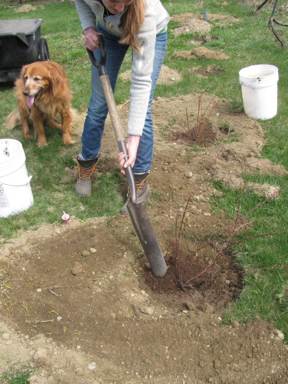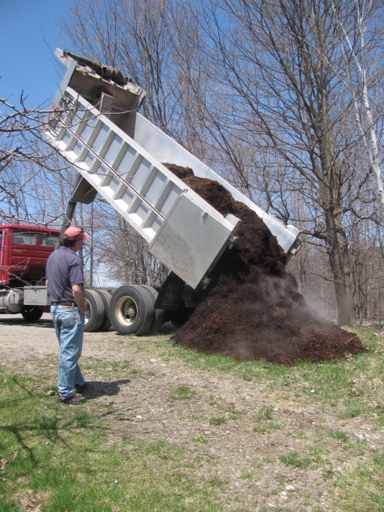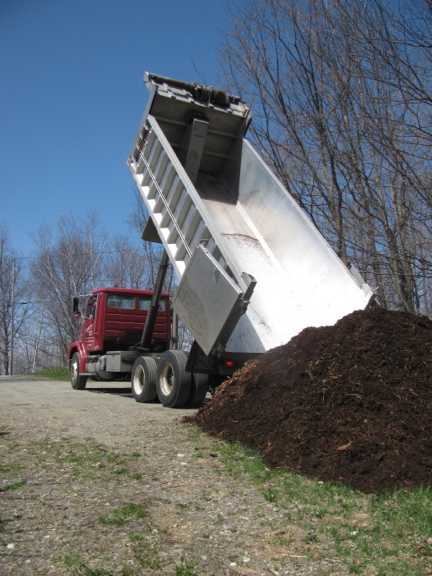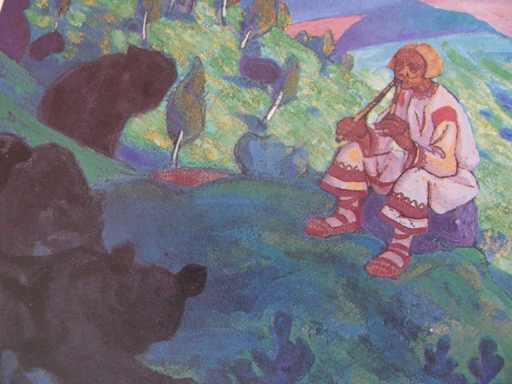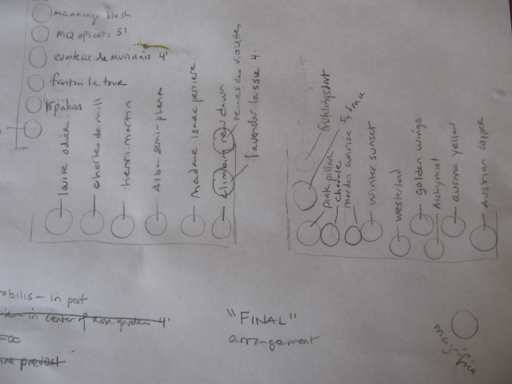As the gardens brim with green shoots and April showers, my thoughts keep returning to my mysterious preoccupation with Roses this winter.
Anyone looking at the gardens might question my use of the word mysterious as the gardens already abound with Roses indicating my attraction to Roses was already quite well developed. Therefore, it should come as no surprise that all during the darkness of the winter season and my time of enforced quiet with my broken arm, Roses filled the space. Yet somehow it does still strike me as mysterious that Roses are calling so loudly and clamoring to be added to the gardens here. There are probably at least five or six dozen roses here already. What is it about Roses?
In the early days of my recuperation, Roses kept me going. I had several old Rose books awaiting me on my bedside table when I fell, and this was wonderfully fortuitous. I was particularly excited to read The Old Shrub Roses by Graham Stuart Thomas, one of the most beloved Rose gardeners and Rose lovers of the last century.
Another book that delighted me was about efforts in the 1970’s to save many old Roses from extinction by collecting cuttings from Texas graveyards as well as the abandoned homes of the miners of the California gold rush. The gold rush happened during a period when the French were highly focused on breeding new Roses. Empress Josephine began the craze when she insisted Napoleon bring her back Roses from everywhere he conquered. Her collection at Malmaison got cross pollinated by bees and the wind, resulting in new Rose creations, and Malmaison’s gardeners also got interested in deliberately mixing these different Roses together to see what would happen. The resulting Roses were spectacular and greatly enlarged the family of Roses.
I find it quite amazing that people would go off to their gold rush claim with a rose cutting from France in their satchels and that a little more than a century later these cuttings gone wild would save a lot of Roses from extinction.
I was also enchanted by a book from the 1950’s entitled, My Friend the Rose by the founder of a lovely old fashioned Rose company called Roses of Yesterday and Today. It is still a place I get Roses. In fact, I expect a shipment from them any moment now!
For many days, I read these books over and over. They created a sort of lifeline, linking me to a continued life in the gardens even as I was having problems with tasks like dressing myself. The books comforted me, gave me hope and felt very expansive.
The first time I picked up a pen, it was to write a scathing commentary on one of the Rose books that I did not like. It was a collection of essays written by famous gardeners on their favorite Roses. This sounded like a nice topic that would result in a sweet book but it was a nasty book full of gardeners writing about why they hated Roses or at the very least found them a troublesome bother. One essay was by Christopher Lloyd who inherited his garden, Great Dixter, from his father. At his father’s death, it seemed he had been waiting his whole life to pull up his father’s Roses and apparently took much delight in de-Rosing the family Rose garden. I could only wish I had been at the Great Dixter compost pile when he did this.
I was befuddled that someone could or would collect so many essays for a book on Roses in which the participants disliked, even hated, Roses. I don’t exactly understand hating Roses. Is it that there is just so much in the culture about them that they seem saccharine or trite? Is it the Roses at garden centers that die on people that have given Roses a bad taste in so many people’s minds?
I have found Roses to be very unpretentious, not at all fussy and generous in their Flowers to an extreme degree. As we further expand the Green Hope gardens this summer, Roses seem a natural choice- so much beauty, relatively little work and offering, in the end of the day, amazing, comforting, wise Flower Essences.
After I read these various books, my bed where I was recuperating was covered in lists, lists and more lists of new Roses I wanted to plant here. The Angels were the voice of reason, narrowing down my oversized lists to a more manageable sized one.
In those days of winter quiet, a new rose garden was born- at least on paper and I knew right where it was going- out behind the perennial beds- even if I was sketchy on how exactly it would get dug by a one armed gardener. Now I know how it will get dug – SLOWLY!
As I look at the final list of what is coming, the names flooded me with wonder and excitement- So many new friends! Here is a brief description of what I will be planting-
Louise Odier– a warm pink Bourbon Rose shaded in lilac that blooms vigorously for a very long season- Bourbon Roses were originally created on the French Island of Reunion way out in the middle of the Pacific (we sent a package there this year!). Bourbon Roses are thought to be the result of the island inhabitants mixing Old Blush China Rose (the mother and grandmother of sooooo many Roses) and Autumn Damask, a old Rose from the middle east.
Madame Isaac Perriere– Perriere, the rose breeder behind this Rose, named this one for his wife. Graham Stuart Thomas says “possibly the most powerfully fragrant of all roses; the flowers are enormous, of intense rose-madder, shaded magenta, bulging with rolled petals, quartered and opening to a great saucer face.â€
Climbing New Dawn– this blush pink and free flowering climbing Rose is wildly popular and blessedly hardy in our northern world which can’t be said for most climbing Roses
Chorale– an elegant light pink Rose in a classic form.
Pink Pillar– another climber of peachy pink citrus scented Roses, reputed to be hardy here in northern New England- Staffer Sophie’s boyfriend Jim is welding me more Rose Arbors- Can you tell?
Reine des Violettes– she was overpowered by the asparagus patch last time she was planted here at the farm so this time, she gets special spot for her unforgettable blossoms of layered deepening violet pink.
Austrian Copper– a single Rose said to be coppery salmon on its upper petals with some yellow on its lower petals. It is from the same family of Roses as the Yellow Rose of Texas though both Roses come originally from the Caucasus mountains –How it came to be called Austrian I have no idea.
Fantin-Latour– a classic beloved as GST said, “scarcely surpassed in beauty, it is a most satisfying Rose in every way and has a delicious fragrance.â€
Mutabilis Rose– a long time Bermuda beloved that will winter in the greenhouse with another Bermuda friend, Old Blush China Rose- This Rose opens one color then transforms to another so that the plant displays salmon pink, orange and yellow Flowers at the same time.
Ispahan– an ancient Damask Rose from Iran with a spicy fragrance, it is described by GST as “neat buds and exquisite half-open blooms…and at all times, a clear and ‘pretty’ pink.â€
Old Black Moss– also known as Nuits de Young in France where all the names sound more poetic- Moss Roses have a sort of sticky moss on the leaves protecting each bud. This moss smells spicy like balsam and though it was an accidental mutation, people liked this fragrance and kept working with it to create a whole group of Roses called Moss Roses. GST says “one of the most famous Mosses, and justly so, on account of its distinct habit and foliage, and the size and colouring of its flowers…beautifully burnished with maroon and metallic tones. The small Flowers are of intense maroon purple, dark and velvety, lit by a few golden stamens.â€
Charles de Mill– as GST says “a compact shrub which makes one of the best displays every year…as for colour, anything from richest crimson-purple, through maroon to dark lilac and wine shades may be found on any bloom at any time.â€
Magnifica– a hardy rugosa Rose with large, fragrant, magenta blossoms. It was first bred by Dr. Van Fleet in 1905. I expect I will love this one as much as Sarah Van Fleet, another Dr. Van Fleet creation.
Henri Martin-this bright clear crimson Rose is a Moss Rose from 1863. GST says it is a particularly graceful plant with “the clearest most intense shade approaching crimson among the Moss Roses that I know†(and GST seems to be on a first name basis with a lot of Moss Roses).
.
Lavender Lassie– a lavender pink Rose of great robustness, this one is a fairly modern Hybrid Musk Rose- Hybrid Musks are disease-resistant, repeat flowering and generally cluster-flowered, with a strong, characteristic “musk” scent.
Mannings Blush– fully double fragrant Rose of white with pink on the petal edges described by GST as “strange but exquisiteâ€- looking forward to seeing what he meant!
Alba Semi-Plena– one of the Roses long grown for Rose oil or attar in Kazanik, Iran, this white Rose has big yellow stamens and GST reports, “a refined air.â€
Double Cinnamon– A Rose at least four hundred years old with bark like cinnamon. It is reputed to be very hardy.
Fruhlingsduft– this one is a creamy apricot colored Rose.
Morden Sunrise– a small semi double Rose that starts out yellow and turns to orange and salmon.
Winter Sunset– created by famous American hybridizer Griffin Buck, this one also changes from yellow to orange.
Comtesse de Murinais– an early hybrid from 1813 France, this Moss Rose has double white petals . To quote our old friend GST, “the blush white of the half-open Flower fades, leaving a milk white well formed bloom with a pronounced button eye…a superlative bloom.â€
Sydonie- a very ruffled pink Rose from the 1840’s in France- Like Fruhlingduft, Morden Sunrise and Winter Sunset, this is one of the Angel’s choices I don’t know much about.
Ausma Yellow Rose– one of David Austin’s early Roses not under strict patent as all his new ones are- I am trying to see which yellow, salmon, orange, apricot hued Roses will thrive here as they don’t generally seem to be as tough as the other Roses.
and last but not least, I am getting another Mary Queen of Scots Rose because Alika completely took over her spot in the original Rose garden.
So that completes the list of pending arrivals. While this may have been an overshare to list all these Roses, at the very least I hope you have enjoyed Graham Stuart Thomas’ way with words- No one describes Roses like him and his books are easy to find on the internet as sadly, every library in America seems to be discarding them-
On a more cheery note, today, a rainy cool April morning, I am going to go out and begin to mark the location for each Rose’s new home. You CAN teach an old dog new tricks- This time round, I am leaving enough room for each Rose to stretch out to its fullest possible size. Not packing them in as I used to do is a new trick for me.
